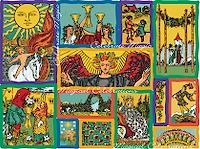By Jeanne Fiorini
Perhaps we should blame Allan Odell of the 1920’s for turning America into a nation of multi-taskers. Apparently Allan thought it wasn’t enough to be out enjoying a peaceful ride in the countryside with the family, but that we also should be musing over roadside rhymes and thinking about shaving lotion.
Yep, let’s blame Burma Shave.
Some of you may remember the folksy red and white Burma Shave limericks, those quirky poems with each line printed on its own small sign, which were posted along the highway up until the 1960’s:
“He tried
To cross
As fast train neared
Death didn't draft him
He volunteered
-Burma-Shave”
And then there’s John Colpitts, employee of the Salada tea company during the 1960’s. He’s the guy who invented that brand’s “tag lines,” those little ditties on the back of the tea tag to keep us entertained while awaiting that perfectly brewed pot. (Are Americans really that bored?) Mr. Colpitts is responsible for statements such as:
“Artists that jog
usually become
good panters.”
While the Burma Shave signs have long since passed their heyday, the “tag line” phenomenon is thriving. These days we’ve come to expect some tidbit of wisdom, humorous pun, or notable quote at the end of our tea bag. I’d consider it a safe bet that many of you have at least one personally significant tea tag posted on your refrigerator at this very moment.
If you’re someone who thinks in terms of the Tarot’s symbols, you can sometimes see a card’s message played out in a tag line slogan. And if you’re someone who pays attention to synchronicities (if you’re into the Tarot, the chances of that are pretty good), you’re likely to find any piece of guidance, even at tea time, a welcome experience. Here are some recent finds from my cupboard’s tea stash:
“The world is a tragedy
to those who feel,
but a comedy to
those who think.”
-Horace Walpole (1717-1797)
Walpole’s commentary on the vagaries of life brings to mind the disparate natures of Cups and Swords, the incongruence of the watery element with that of air.
Anyone who identifies themselves with the suit of Cups and its non-rational, ever-fluid collection of emotions would likely confirm that empathy and compassion often do lead to heartache. As for the thinkers among us, those objective souls whose resistance to the pangs of uncertainty and fear allow them to observe the world with a discriminating eye, the scenery of life must certainly seem outrageously ridiculous.
Of course, the lesson of the Tarot is to establish integration with the All so that Consciousness may experience itself fully (The World card). Ah, to live in That Place, or with the Fool, at peace with “what is” and savoring every moment!
Can any Tarotist read the following and not think of the various aspects of The Hierophant card?
“The tribute to
learning is teaching.”
-Wise Saying from the Orient
It is, in fact, the inextricable link between the teacher and the student that often renders the Hierophant card difficult to interpret: Who is in what role? What do I learn? What do I teach? Do these things both happen in the same moment?
Importantly, in many Tarot decks, the Hierophant does not stand alone in his card. A teacher isn’t a teacher without a student. We might note this as one of the significant differences between the Hierophant and the Hermit: both have knowledge and insight, but the Hierophant is motivated to share wisdom with community, whereas the Hermit utilizes wisdom to develop his inner life.
“He who would leap high
must take a long run.”
-Danish Proverb
This one’s for all the late-bloomers in the crowd. (Do you feel like the Strength card runs your life?) The statement also brings up an idea I call the “mythical plateau of attainment,” that cruel notion that there is an age/date/time at which moment your life will be “all set.” I haven’t gotten there yet, have you?
In numerological terms, this proverb reminds me of those people whose personal numerology gives them a 20/2 combination: a personality card of Judgment and a soul card of the High Priestess. (For an overview of Numerology and Tarot check out Mary Greer’s Tarot for Yourself (ISBN 0-87877-077-1, pages 11-18).
There is a very wide stretch, both in the number of steps and in symbolic meaning, between the passive receptivity of the High Priestess (2) and the confident, dynamic movement of the Judgment (20) card. Those who hold this polarity within themselves must know that it takes eons of patience and observation before one is truly ready to stand in a place of irrevocable action. Personal preparation for a high leap does indeed require a long run.
Not to sound like a curmudgeon, but there’s a lot of Aquarian-age stuff as well as consensus-reality thinking flying around right now that is either fluff, blatantly erroneous, psycho-babble pabulum, or just plain nonsense. (The Devil card energy is doing its work to keep us distracted.) At the same time, some essential awareness is being brought into the minds of people, ideas that are crucial not just for our expansion, but for our survival.
At this important time, we all have to be discriminating about what we let into our consciousness and what we allow to become imbedded into our belief systems. The state of consciousness is the primary battleground for the state of the world, and we need to be vigilantly clear and assertively positive about which thoughts and beliefs shape our reality (An Ace of Swords activity, the ability to cut the ties by which The Devil would maintain control).
With that thought in mind, I offer this final tag line with the encouragement to remember that we as individuals are the ones who decide what is true and real, and that we need to choose carefully:
“Pearls of wisdom
are very rare.”
-Salada
© 2008 Jeanne Fiorini

